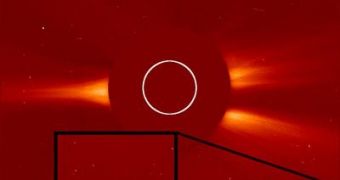The Solar and Heliospheric Observatory was first designed for a mission destined to study the Sun and its activity, which is what it still continues to do after nearly 13 years since it was launched into space by the European Space Agency. Who would have thought back then that SOHO would later become the biggest comet discoverer in all history? On June 25, SOHO set a new world record by discovering its 1,500th comet.
The discovery was in fact made by American amateur astronomer Rob Matson. The newly found celestial body is part of a bunch of comets, known as the Kreutz-group, which have orbits very close to the Sun and have been observed for hundreds of years in the history of mankind. The closest they've come to the Sun was at 0.01 Astronomical Units, meaning roughly 1,460,000 kilometers.
Because SOHO orbits on a trajectory always located between the Sun and the Earth, it is the most privileged when it comes to observing the space area in the immediate vicinity of the Sun, this being available for observers on Earth only during eclipses. The vast majority of bodies it discovers are mostly fragments of bigger comets that came apart during some past encounter with the powerful gravitational field of the Sun and were eventually destroyed by the solar radiation over the span of a couple of hundred years during repeated close approaches to the Sun.
SOHO can see these fragments as they are being evaporated with the help of the Large Angle and Spectrometric Coronograph, LASCO for shorts, one of the 12 instruments on board the spacecraft. The rest of the detective work must then be done by astronomers. Since data can become available in as little as 15 minutes from the time it was collected, basically anyone who is willing to do volunteer work can access it from every corner of the world.
Once a possible detection is made, it is announced to Karl Battams from the Naval Research Laboratory, who then makes all the final checks and afterwards reports back to the Minor Planet Center, where they catalogue the newly discovered object and calculate its orbit.
"This is allowing us to see how comets die. It's a unique data set and could not have been achieved in any other way," said Battams. This is because such comets evaporate at a faster rate than any other comets coming through the vicinity of the Sun.
"Catching the enormous total of comets has been an unplanned bonus," says Bernhard Fleck, ESA SOHO Project Scientist.

 14 DAY TRIAL //
14 DAY TRIAL //